|
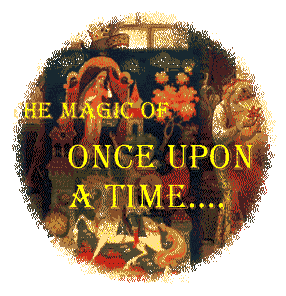
Narrative Logo - Click for Main Menu
IX. The Politics
of Storytelling

Caption: Pogo for President Pin
Another President who captured the public imagination and functioned
as a kind of modern legend of the time was Teddy Roosevelt. You will recognize his
sayings, starting from "speak softly and carry a big stick." When we think
of what kind of mythology a campaign adopts, the "Rough Riders" suggests that
America still wants to think of itself as a frontier land . . .
.

Caption: Teddy Roosevelt - the Rough Rider with a
Big Stick
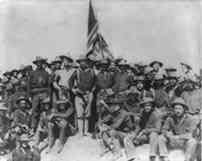
Caption: Roosevelt with his Rough Riders
To illustrate the ways in which our traditional folklore enters into
the ongoing political drama, consider the strange case of the John Wilkes Booth mummy.
This story from: The Discovery Channel--History Buff
page.
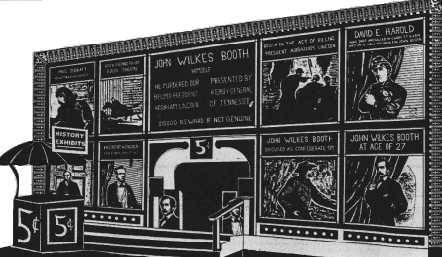
Caption: Marquee for John Wilkes Booth exhibit
Most historians allege that John Wilkes Booth, the
assassin of Abraham Lincoln,
was killed in Garrett's barn on April 26, 1865. Because there was so much
mystery surrounding the autopsy and subsequent burial of Booth, some held
the belief that Booth didn't really die that night. Some claimed that Booth had
actually escaped and that the man shot in the barn wasn't really Booth. They
further believe that when officials in the American government discovered that
they had the wrong man, to escape embarrassment, the matter was quickly
covered up. The controversy settled down by the time that the conspirators' trial
was over. There were a few brief rumbles again in 1867 with the John Surratt
trial but they too quickly ended. In the Spring of 1898 there was much
newspaper coverage relating that Booth had escaped death in the burning barn
in 1865 and made his way to South America. It wasn't until 1903 that the
question of Booth's escape surfaced again.
On January 13, 1903 a man in Enid, Oklahoma, by the name of David E.
George died. in his last dying statement, the man confessed to his landlord,
Mrs. Harper, that he was in fact John Wilkes Booth. This was soon the topic of
discussion around town. The January 22, 1903 Enid Wave bore the following
article banked with headlines:
WAS IT BOOTH?
The Impression Growing, From Evidence,
Circumstantial and Otherwise, that
the Supposed Remains of
David E. George are None
Other Than the Remains of
JOHN WILKES BOOTH!
From the first the Wave has not believed that it is probable that David E.
George... was John Wilkes Booth, the assassin of Abraham Lincoln, however, it
is possible. The evidence of Mrs. Harper as to the fact George confessed to
her... that he was none other than Booth, the assassin, in connection with the
striking likeness to the assassin and the general demeanor of the man in
producing parts of Shakespeare's' plays and songs around the saloons leads to
a possibility in this case...
THE CURSE
The postmortem career of John Wilkes Booth, whether it belongs to true history
or folklore, none-the-less provides a fascinating story. The mummy scattered
ill-luck around almost as freely as Tutankhamen is alleged to have done. Nearly
every showman who exhibited the mummy was subsequently ruined financially.
Eight people were killed in the wreck of a circus train in 1902 on which the
mummy was traveling. Bill Evans, a wealthy carnival king, who bought the
exhibit in later years was financially ruined by continual strokes of bad luck after
the purchase. Finis L. Bates, the original owner, wrote a book in 1908 entitled
"The Escape and Suicide of John Wilkes Booth" which attempted to prove that
the mummy was in fact John Wilkes Booth. he suffered much ridicule because
of that book and died penniless in 1923. Perhaps the only person to sponsor
the mummy and not suffer strokes of financial bad luck was Reverend True
Wilson. It must be pointed out that Wilson was largely responsible for originally
getting the prohibition law passed. However, shortly after Wilson bought the
mummy, the repeal of the prohibition law was made official. (Let each reader
make their own determination as to whether this was a cause-effect in this case
or not.)
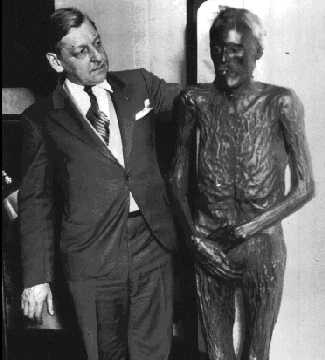
Caption: Museum Curator with Booth Mummy
More recent legends, and harking to our studies of Camelot and the
Arthurian legendstock:
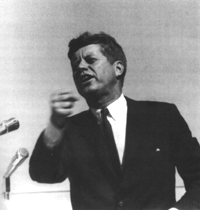
Caption: President John F. Kennedy
The legend-making, and the underground mythology of the Kennedy
years seem real to me, yet. But almost 40 years have passed, now, and the Kennedy
legendstock is now taking shape in the way that folk material does . . . .
There is the Camelot
of the John-and-Jackie years, the considerable mythologizing about the Kennedy
assassination, and the linkage with other martyrs. Kennedy has been, for example,
linked with Abraham Lincoln.
Facts about President Lincoln
Elected 1860.
Lost his son while serving as president.
He was a second child.
Was elected on November 8th for the term in which he was assassinated.
Shot on a Friday, in the head, from behind, with his wife present.
His vice-president, who succeeded him, was named Andrew Johnson.
His assassin, John Wilkes Booth, was born in 1839.
Booth shot Lincoln in a theater and escaped to a barn.
Booth was killed before his trial.
John Wilkes Booth was best known by all three names.
Facts about John Kennedy
Elected 1960.
Lost a son while serving as president.
He was a second child.
Was elected on November 8th for the term in which he was assassinated.
Shot on a Friday, in the head, from behind, with his wife present.
His vice-president, who succeeded him, was named Lyndon Johnson.
His assassin, Lee Harvey Oswald, was born in 1939.
Oswald shot Kennedy from a warehouse and escaped to a theatre.
Oswald was killed before his trial.
Lee Harvey Oswald was best known by all three names.
Continue
with Lecture IX.
|






